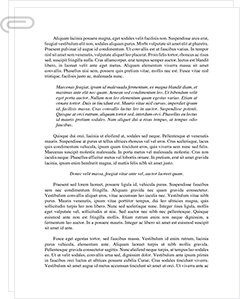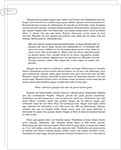 Study Document
Study Document
Market Structure and Pricing Practices Research Paper
Pages:10 (2884 words)
Sources:5
Document Type:Research Paper
Document:#57223489
Managerial EconomicsOutlineIntroductionOverview of Market StructureOverview of PricingRelationship between Market Structure and Pricing StrategyMarket Structure Pricing Practices Pricing Practices for Monopolistic, Monopolistic Competition, and Oligopolistic Markets Pricing Practices for Perfect Competition Markets Price Matching Inducing Brand Loyalty Randomized PricingConclusionReferencesMarket Structure Pricing PracticesMarket structure is one of the major factors that shape decisions made by business owners and managers. Generally, business owners and managers do not make decisions in a vacuum as they consider various factors including market structure. Market structure is an important aspect of decision-making in businesses as it shapes decisions on how much output to produce and pricing of products/services (Baye & Prince, 2017). The consideration of these factors is essential to promote business success and profitability. Given its impact on pricing or products/services, there is a nexus between market structure and pricing practices. In this regard, decisions on pricing are influenced by consideration of the market structure. This research paper discusses the nexus between market structure and pricing strategies as well as market structure pricing practices.Overview of Market StructureBaye & Prince (2017) define market structure as factors like the number of businesses competing in a market, size of these businesses, demand conditions, technological and cost factors, and the ease of entry and exit. A market structure is a term used to refer to a tool used in business decision-making in relation to the external business environment. In essence, the market structure provides business owners and managers with insights regarding the external business environment. These insights in turn shape the decisions and strategies adopted by business owners to ensure and promote the profitability and success of their businesses. Without an understanding of the market structure, business owners and managers will be unable to make appropriate decisions to promote the effective operations and profitability of their businesses. Therefore, market structure is a core characteristic for the operations of a business entity.As a key factor in determining economic efficiency, market structure comprises different variables that shape managerial decisions. One of these variables is firm size, which implies the considerable variations in the size of businesses operating in a particular market. Each market has firms of different sizes ranging from small to large companies. A firms relative position in the industry is affected by various factors including changes in strategies adopted by rivals and changes in market conditions. The differences in firm size contribute to variations in sales, profitability, and revenues.The second variable in market structure is industry concentration, which refers to distribution of firms within an industry. Industry concentration is an important aspect of managerial decisions as it determines the level of competition a business is likely to face in a particular industry. Markets vary in terms of industry concentration since some industries comprise many small firms while others are dominated by a few large firms (Baye & Prince, 2017). Technological and cost factors are the other variables of the structure of the market and relate to the technologies and costs of production of goods and services. The variations in technology used to produce goods and services contribute to differences in production techniques and measures across industries. These techniques in turn shape cost factors, which are also affected by the labor required in production processes.Industries also vary in terms of demand and market conditions as well as the potential for entry and exit. Industries with low demand are characterized by the existence of only a few firms, which are adequate to sustain the market. On the contrary, industries with high demand are characterized by the presence of many firms to produce the demanded quantity of goods and services. Additionally, some industries…
…employed in perfect competition markets to help enhance profits and lessen the intensity of rivalry. Companies that use this strategy seek to induce brand loyalty as a means of reducing the number of customers who will switch to substitute products in the market. By employing this pricing strategy, companies seek to leverage their competitive advantage to remain profitable amidst intense competition. This pricing practice is based on the idea that brand-loyal customers will continue to purchase a companys products or services even if a competitor offers a slightly cheaper or better price. However, this strategy tends to be ineffective if consumers believe that the offered goods and services are homogenous.Randomized PricingThe final pricing practice employed by firms in this market structure is randomized pricing in which a company varies the cost of its products and services from hour to hour or day to day. When this strategy is employed, customers cannot identify firms that charge the lowest price in the market. Additionally, when utilized, randomized pricing lessens the ability of rival companies to destabilize its price. The effectiveness of this pricing strategy requires the use of advertising channels with a wider reach.In conclusion, market structure is a term used to refer to market conditions that shape major business decisions. Some of these conditions include the number of businesses competing in a market, size of these businesses, demand conditions, technological and cost factors, and the ease of entry and exit. There is a strong link between market structure and pricing practices because market conditions influence product and/or service pricing. Market structure affects pricing practices by shaping the behaviors of buyers and sellers as well as the behaviors of producers. Given the difference in market structures, pricing practices differ as businesses seek to enhance their profits and revenues. Businesses set pricing objectives and…
Related Documents
 Study Document
Study Document
Market Structure: Simulation, Table and
With respect to its operations, Verizon Wireless is unparalleled. Indeed, it "is one of the strongest competitors due to the foundation of its large nationwide service area and strong customer base. With two quarters of 1.9 million net additions, it has set the bar for competitors to reach." (BW, 1) This is based on a convergence of extremely visible advertising tactics via television, radio, billboard and sponsorship with a service
 Study Document
Study Document
Market Structure and Pricing Strategies
market structures in detail and analyses the pricing strategies that the firms have to undertake when they operate in different regimes. The case study on Toyota is considered next, which indicates that firms competing in various structures does not only have to focus on price and quantity ceteris paribus, they also have to consider external and internal variables that have a bearing on these decisions. Introduction to Market Structures Market structures
 Study Document
Study Document
Operations Decisions Market Structure Is a Microeconomics
Operations Decisions Market structure is a microeconomics term that encompasses the interconnected attributes of a market. The variables examined when considering market structure include characteristics of buyers and sellers, competition, product differentiation, and ease of moving into and from the market. Factors such as the number and strength of buyers and sellers, along with any collusion that may develop among them, are very influential on market structure, as evident in this
 Study Document
Study Document
Economic Analysis of Supply and Market Structure of Healthcare Industry...
Product or Service Supplied
The product supplied to patients is generic pharmaceuticals. “A generic drug is a pharmaceutical drug which is equivalent to a brand-name product in dosage, route of administration, strength, quality, Kinetics, and its intended use. It may also refer to any drug which is marketed under its chemical name without advertising” (Moin, 2016). The importance to the customer is an issue of affordability: the patient has to incur fewer
 Study Document
Study Document
Pricing Strategies Price and Cost Variables Are
Pricing Strategies Price and cost variables are not fixed. At times, there are some fixed elements to these costs but in many instances these costs are subject to fluctuation. These fluctuations can derive from changes in buying power, changes in commodity prices and other considerations. Likewise, forces in the external environment can bring about changes in the prices the firm can charge. When uncertain variables are fixed, the company can find
 Study Document
Study Document
Market Leadership Report Final Project
Office Depot started its operation five years after Staples. The company has aligned its business strategy to target increasing its market share through business policies similar to those undertaken by Staples Inc. The company is locally owned and faces difficulties in capital expansion to be able to roll more distribution outlets similar to Staples. This has incapacitated the company in acquiring economic of scale in operation. The company currently




